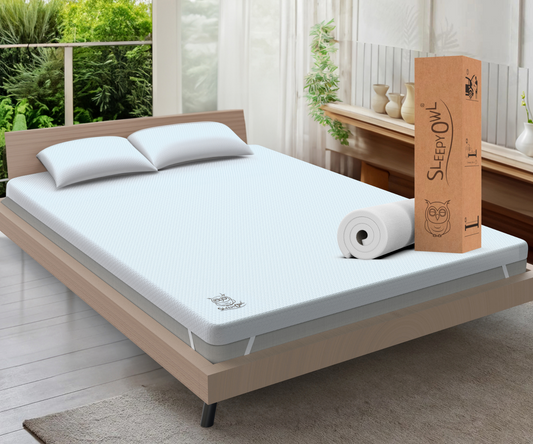How Room Temperature Affects Your Memory Foam Mattress Topper
Memory foam, originally developed by NASA in the 1960s for use in aircraft cushions, has evolved into a popular material for bedding products, particularly mattress toppers. This viscoelastic foam is known for its unique ability to conform to the shape of the body, providing personalized support and pressure relief. When weight is applied, memory foam softens and molds to the contours of the sleeper, distributing body weight evenly across the surface.
This characteristic not only enhances comfort but also helps alleviate common sleep-related issues such as back pain and joint discomfort. The composition of memory foam typically includes polyurethane and various additives that enhance its properties. The density of the foam plays a crucial role in determining its firmness and durability.
Higher-density memory foam tends to offer better support and longevity, while lower-density options may feel softer but can wear out more quickly. Additionally, many manufacturers incorporate cooling technologies into their memory foam toppers, such as gel infusions or open-cell structures, to mitigate heat retention—a common concern among users. Understanding these material properties is essential for selecting the right memory foam mattress topper that aligns with individual sleep preferences. Check out this amazing Memory Foam Mattress Topper for a better night's sleep.
The Impact of Room Temperature on Memory Foam Mattress Toppers
Temperature Sensitivity
Memory foam reacts to heat by becoming softer and more pliable, which can affect how well it conforms to the sleeper's body. In warmer environments, the foam may become excessively soft, leading to a feeling of being "stuck" or sinking too deeply into the mattress.
Optimal Temperature Range
Conversely, in cooler conditions, memory foam can become firmer and less responsive, potentially resulting in inadequate support and discomfort during sleep. The ideal room temperature for optimal memory foam performance typically falls within the range of 60 to 67 degrees Fahrenheit (15 to 19 degrees Celsius). At this temperature range, the foam maintains a balance between softness and support, allowing it to contour effectively to the body while still providing adequate resistance.
Factors Influencing Room Temperature
However, many variables can influence room temperature, including seasonal changes, heating and cooling systems, and even personal preferences. Understanding how these variables interact with memory foam can help users create a more conducive sleep environment.
Benefits of a Cool Room Temperature for Memory Foam Mattress Toppers
Maintaining a cool room temperature can enhance the overall performance of a memory foam mattress topper in several ways. First and foremost, cooler temperatures help prevent excessive heat retention, a common issue with traditional memory foam. When the room is kept cool, the topper remains more responsive and supportive, allowing for better spinal alignment and reducing the risk of discomfort during sleep.
This is particularly beneficial for individuals who tend to sleep hot or experience night sweats. Additionally, a cooler environment can promote deeper sleep cycles. Research indicates that lower ambient temperatures can facilitate the body's natural thermoregulation processes during sleep, leading to improved sleep quality.
When the body is not working hard to cool itself down due to an overly warm environment, it can enter deeper stages of sleep more easily. This results in increased restorative sleep, which is essential for physical recovery and cognitive function. Therefore, keeping the room cool not only enhances the performance of the memory foam topper but also contributes to overall health and well-being.
Drawbacks of a Warm Room Temperature for Memory Foam Mattress Toppers
While some individuals may find comfort in a warmer sleeping environment, elevated room temperatures can pose significant drawbacks for those using memory foam mattress toppers. One of the primary concerns is heat retention; traditional memory foam tends to absorb and retain body heat, which can lead to an uncomfortable sleeping experience. In a warm room, this effect is exacerbated, causing the sleeper to feel overheated and restless throughout the night.
Moreover, when memory foam becomes too warm, it loses its ability to provide adequate support. The material may become overly soft and fail to maintain its structural integrity, leading to poor spinal alignment and increased pressure on sensitive areas such as the hips and shoulders. This can result in discomfort and even pain upon waking.
For those who are already prone to musculoskeletal issues or have specific sleep needs, a warm room temperature can significantly hinder their ability to achieve restorative sleep.
Tips for Maintaining an Optimal Room Temperature for Your Memory Foam Mattress Topper
To ensure that your memory foam mattress topper performs at its best, it is essential to maintain an optimal room temperature. One effective strategy is to use a programmable thermostat that allows you to set specific temperatures for different times of day or night. This way, you can ensure that your bedroom remains cool during sleeping hours while allowing for a warmer environment during waking hours.
Another practical tip is to utilize fans or air conditioning units to regulate airflow within the room. Ceiling fans can help circulate air and create a more comfortable sleeping environment without drastically altering the temperature. Additionally, consider using breathable bedding materials such as cotton or linen sheets that wick moisture away from the body and promote airflow around the mattress topper.
These small adjustments can make a significant difference in maintaining an ideal sleeping temperature.
How Room Temperature Affects the Longevity of Your Memory Foam Mattress Topper
The longevity of a memory foam mattress topper is closely tied to environmental factors, particularly room temperature. Excessive heat can accelerate the breakdown of materials within the foam, leading to premature wear and loss of support over time. When memory foam is subjected to high temperatures consistently, it may develop permanent indentations or sagging areas that compromise its structural integrity.
Conversely, maintaining a stable and moderate room temperature can help extend the lifespan of your mattress topper. By preventing overheating and ensuring that the material remains within its optimal performance range, users can enjoy their investment for many years without experiencing significant degradation. Regularly rotating or flipping the topper (if applicable) can also help distribute wear evenly and further enhance its durability.
Adjusting Room Temperature for Different Seasons with Your Memory Foam Mattress Topper
As seasons change, so too do the challenges associated with maintaining an optimal room temperature for your memory foam mattress topper. In winter months, heating systems may cause indoor temperatures to rise significantly, leading to potential overheating during sleep. To combat this issue, consider using a humidifier in conjunction with your heating system; this can help maintain moisture levels in the air while keeping temperatures comfortable.
During summer months, air conditioning becomes essential for keeping indoor temperatures cool and comfortable. However, it's important to avoid setting the thermostat too low; excessively cold environments can also negatively impact memory foam performance. Aim for a balanced approach by setting your air conditioning unit to maintain temperatures within the recommended range while using fans or open windows during cooler evenings to promote airflow.
Other Factors to Consider for the Best Performance of Your Memory Foam Mattress Topper
While room temperature plays a critical role in optimizing the performance of memory foam mattress toppers, several other factors should also be considered. Humidity levels are one such factor; high humidity can exacerbate heat retention issues by preventing moisture from evaporating from the body during sleep. Using dehumidifiers or ensuring proper ventilation can help mitigate this problem.
Additionally, personal preferences regarding bedding materials and sleep positions should be taken into account when selecting a memory foam mattress topper. For instance, side sleepers may benefit from softer toppers that provide additional cushioning for pressure points, while back sleepers might prefer firmer options that offer better support for spinal alignment. Ultimately, understanding how various elements interact with your memory foam mattress topper will enable you to create an ideal sleeping environment tailored to your unique needs.
FAQs
What is the ideal room temperature for a memory foam mattress topper?
The ideal room temperature for a memory foam mattress topper is between 60-67 degrees Fahrenheit. This temperature range allows the memory foam topper to maintain its supportive and comfortable properties.
How does a higher room temperature affect a memory foam mattress topper?
A higher room temperature can cause a memory foam mattress topper to become softer and less supportive. This can lead to decreased comfort and potential issues with spinal alignment during sleep.
How does a lower room temperature affect a memory foam mattress topper?
A lower room temperature can cause a memory foam mattress topper to become firmer and less pliable. This can lead to decreased comfort and potential issues with pressure relief during sleep.
Can extreme temperatures damage a memory foam mattress topper?
Extreme temperatures, both hot and cold, can potentially damage a memory foam mattress topper. Excessive heat can cause the foam to break down, while extreme cold can make the foam more brittle and prone to damage.
How can I maintain the ideal room temperature for my memory foam mattress topper?
To maintain the ideal room temperature for a memory foam mattress topper, it's important to keep the room well-ventilated and use heating or cooling systems as needed to stay within the recommended temperature range. Additionally, using a mattress protector or topper cover can help regulate temperature and protect the memory foam.


